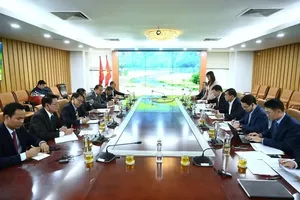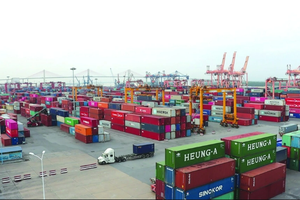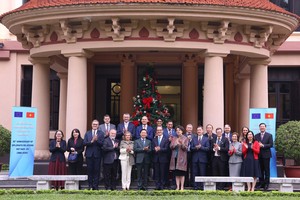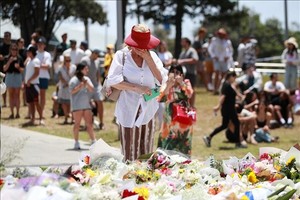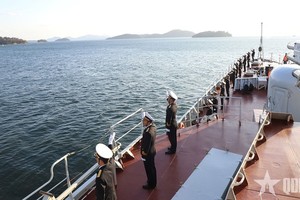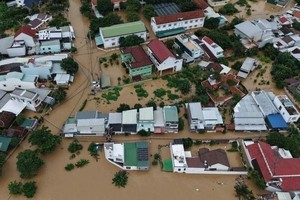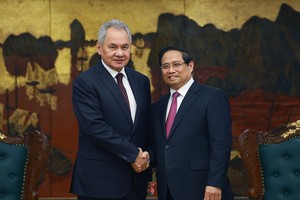Workers grappled Sunday with how to remove and store highly radioactive water pooling in four troubled units at a nuclear power plant in northeastern Japan that has been leaking radiation making its way into food and water.
The discovery of puddles with radiation levels 10,000 times the norm sparked a temporary evacuation of the Fukushima Dai-ichi power plant on Thursday. Two workers who stepped into the water were hospitalized with possible burns.
The development set back feverish efforts to start up a crucial cooling system knocked out in a massive March 11 earthquake and tsunami, but has helped experts get closer to determining the source of the dangerous leak.
Chief Cabinet Secretary Yukio Edano, speaking Sunday on TV talk shows, said the radioactive water is "almost certainly" seeping from a reactor core.
Workers were focusing Sunday on extracting the contaminated water from three of the plant's six reactors and trying to find a safe place to store or dispose of it, said officials from the plant's operator, Tokyo Electric Power Co., or TEPCO.
With just one pump incapable of handling the large amounts of water, two more will be brought in to help speed up the process, said Hidehiko Nishiyama of Japan's Nuclear and Industrial Safety Agency, or NISA.
It has been more than two weeks since the magnitude-9 quake erupted off the coast, triggering a tsunami that swallowed up cities and left a swath of devastation along Japan's northeast.
The wave also engulfed and damaged the Fukushima power plant, creating a nuclear crisis that has threatened to overshadow efforts to care for hundreds of thousands of homeless and address the global economic fallout created by the twin disasters.
The government has voiced criticism of TEPCO's handling of the crisis following a series of missteps in recent days.
Edano urged TEPCO to be more transparent after NISA revealed that the plant operator was aware there was high radiation in the air at one unit several days before the two workers were burned.
"Regardless of whether there was an awareness of high radioactivity in the stagnant water, there were problems in the way work was conducted," Nishiyama said Saturday.
NISA warned TEPCO to improve and ensure workers' safety, and TEPCO has taken measures to that effect, Nishiyama said, without elaborating.
TEPCO spokesman Hajime Motojuku declined to comment late Saturday.
The protracted nuclear crisis has spurred concerns about the safety of food and water in Japan, which is a prime source of seafood for some countries.
Radiation has been found in milk, seawater and a range of vegetables, including broccoli, cauliflower and turnips.
Tap water in several areas of Japan, including Tokyo, showed higher-than-normal levels of radiation, prompting officials to distribute bottled water to families with infants.
Just outside a reactor at the coastal nuclear plant, radioactivity in seawater tested about 1,250 times higher than normal, Nishiyama said. He said the area is not a source of seafood and that the contamination posed no immediate threat to human health.
However, tests conducted 18 miles (28 kilometers) offshore found radioactive iodine-131 at levels nearing the regulatory limit set by the Japanese government, the International Atomic Energy Agency said. The tests also detected another radioactive substance, cesium-137, at lower levels.
IAEA experts said the ocean would quickly dilute the worst contamination. Radioactive iodine breaks down within weeks but cesium could foul the marine environment for decades.
TEPCO has been using seawater to try to cool the plant, but fears are growing that the corrosive salt in the water could further damage the machinery inside the reactor units.
The plant began switching to fresh water over the weekend. The U.S. military is sending barges loaded with 500,000 gallons of fresh water to nearby Onahama Bay, the U.S. 7th Fleet said.
Nuclear safety officials revealed Friday that they suspected a breach in one or more of the plant's units, but said they didn't know the source of the radioactive water. Such a breach could mean a much larger release of radioactive contaminants.
The development raised concerns about the 500-600 workers taking turns at the plant.
The workers who stepped into the contaminated water Thursday were exposed to radiation at levels between 2,000 and 6,000 millisieverts, the International Atomic Energy Agency said Sunday. Health authorities say whole-body exposure to more than 3,000 millisieverts in a short period can spur radiation sickness and death in a large population.
The nuclear crisis has added to the misery and uncertainty facing Japan, with no sense of an end to a disaster Edano warned would take "a long time" to resolve.
Japanese soldiers and U.S. Marines were clearing away debris so they could keep searching for bodies and bury the dead. The official death toll Sunday was 10,489, with more than 16,600 listed as missing, police said. Those lists may overlap, but the final death toll was expected to surpass 18,000.
Overwhelmed by bodies along the coast, government officials conducted more mass burials — another tragedy in a country with a tradition of mourning its dead with highly formalized Buddhist ceremonies.
In Yamamoto, relatives wailed and yelled their farewells as the first 11 caskets were buried in one end of a long mass grave in a vegetable patch, with at least 400 more burials planned in the coming days.
In Higashimatsushima, soldiers lowered plywood coffins into a ditch dug at a recycling plant as freezing rain fell on mourners weeping quietly under umbrellas.
Hundreds of thousands are still sleeping on crowded school gymnasium floors with few comforts. Those living within a 12-mile (20-kilometer) radius of the plant have been evacuated.
Life was also tough in the ghost towns inside a larger voluntary evacuation zone, with most residents choosing to flee and wary truckers refusing to deliver goods.
Muneyuki Munakata, a 58-year-old firefighter evacuated from his home near the nuclear plant, has been living in a shelter about 25 miles (40 kilometers) west of the complex. Evacuees have plenty of instant noodles, but not enough rice or fuel for the stove.
"People here are all exhausted," he said. "We all talk about when we can go home, but I don't know when because of uncertainty over the nuclear disaster."
